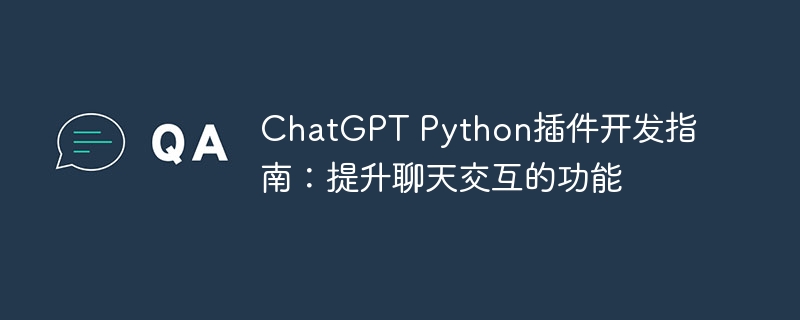

ChatGPT Python plug-in development guide: To improve the function of chat interaction, specific code examples are required
Introduction:
ChatGPT is a powerful chat robot launched by OpenAI Model can realize human-computer dialogue interaction. In order to further enhance the functionality of ChatGPT, the OpenAI team allows developers to customize plug-ins to enhance the interactive capabilities of the chatbot. This article will introduce how to develop a Python plug-in for ChatGPT and provide some specific code examples.
1. Plug-in development preparations
Install ChatGPT: First, make sure you have installed OpenAI’s ChatGPT library. You can install the latest version by using the pip command:
pip install openai
2. Create the ChatGPT plug-in
Import the required modules:
First, import the necessary modules to develop the ChatGPT plug-in.
import openai import json
Initialize ChatGPT:
Next, initialize the ChatGPT model using the API key.
openai.api_key = 'YOUR_API_KEY'
Define plug-in function:
Create a function to extend the functionality of ChatGPT. This function receives the text entered by the user, calls the ChatGPT model, and returns the bot's reply.
def chat_with_plugin(input_text):
response = openai.Completion.create(
engine="text-davinci-003",
prompt=input_text,
max_tokens=100,
temperature=0.7
)
return response.choices[0].text.strip()3. Test the ChatGPT plug-in
You can now use the plug-in function defined above for testing. The following is a simple example:
user_input = "你好,我是一个开发者" bot_response = chat_with_plugin(user_input) print(bot_response)
4. Further development of the plug-in - using context
Update the plug-in function:
In order to enhance the conversation coherence of ChatGPT, you can Use contextual information as input. Here is an example of a modified plug-in function:
def chat_with_plugin(input_text, context=None):
if context:
prompt = f"{context}
User: {input_text}"
else:
prompt = input_text
response = openai.Completion.create(
engine="text-davinci-003",
prompt=prompt,
max_tokens=100,
temperature=0.7
)
if context:
response_text = response.choices[0].text.strip()
bot_response = response_text[len(context):].strip()
else:
bot_response = response.choices[0].text.strip()
return bot_response Testing the plug-in function with context:
Now, you can use the context information for testing. The following is an example:
context = "早上打了一场激烈的篮球比赛" user_input = "我感觉累得不行" bot_response = chat_with_plugin(user_input, context) print(bot_response)
Conclusion:
Through custom plug-ins, we can further extend the functionality of ChatGPT and provide more intelligent and personalized chatbot interactions. This article describes how to develop a Python plug-in for ChatGPT and provides some specific code examples for reference. Developers can further try different plug-in functions and optimizations on this basis. I wish you develop more excellent ChatGPT plug-ins!
The above is the detailed content of ChatGPT Python Plug-in Development Guide: Improving Chat Interaction Functions. For more information, please follow other related articles on the PHP Chinese website!




